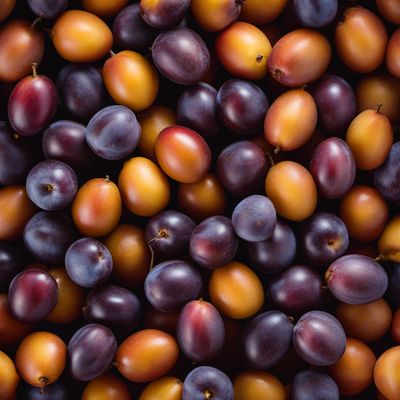
Ingredient
Hog plums
The Tangy Delight
Hog plums are small, oval-shaped fruits with a greenish-yellow skin and a firm, juicy flesh. They have a unique combination of sweet and sour taste, similar to a cross between a mango and a pineapple. The texture is crisp and fibrous, with a slightly grainy mouthfeel. The vibrant yellow flesh contrasts beautifully with the green skin, making it visually appealing in both raw and cooked preparations.
Origins and history
Hog plums are native to Southeast Asia and are widely cultivated in tropical regions around the world. They have a long history of culinary use in countries like India, Sri Lanka, and Thailand. In these regions, hog plums are often used in chutneys, pickles, curries, and desserts. They are also enjoyed as a refreshing snack when eaten raw.
Nutritional information
Hog plums are low in calories and a good source of vitamin C, fiber, and antioxidants. They also contain small amounts of vitamin A and potassium.
Allergens
There are no known allergens associated with hog plums.
How to select
When selecting hog plums, look for fruits that are firm and free from blemishes or bruises. The skin should have a vibrant greenish-yellow color. Avoid fruits that are overly soft or have a strong odor, as they may be overripe.
Storage recommendations
To maintain the freshness of hog plums, store them at room temperature until ripe. Once ripe, they can be refrigerated for up to a week. To extend their shelf life, you can also freeze hog plums by removing the skin, pitting them, and storing in an airtight container.
How to produce
Hog plums can be grown in tropical or subtropical regions with warm climates. They thrive in well-drained soil and require regular watering. It is best to propagate hog plums from seeds or by grafting onto a compatible rootstock.
Preparation tips
Hog plums can be enjoyed in various ways. They can be eaten raw, sliced and added to salads, or used as a topping for desserts. In savory dishes, hog plums can be used to make tangy chutneys, sauces, or added to curries for a burst of flavor. They can also be used to make refreshing beverages or infused into vinegar for a tangy twist.
Culinary uses
Hog plums are commonly used in Southeast Asian cuisines, particularly in India, Sri Lanka, Thailand, and Malaysia. They are also found in Caribbean and Latin American cuisines, where they are used in salsas, sauces, and desserts.
Availability
Hog plums are commonly available in tropical regions such as Southeast Asia, India, Sri Lanka, and parts of the Caribbean. They can also be found in specialty grocery stores or markets that cater to international cuisines.
More ingredients from this category » Browse all

Water berries
"The Refreshing Gems: Exploring the World of Water Berries"

Acerolas
Vibrant Superfood Berries

Otaheite gooseberries
The Tropical Delight: Otaheite Gooseberries

Coco plums
The Tropical Delight

Grumichamas
The Exotic Brazilian Berry

Water pears
The Refreshing Delight: Exploring the World of Water Pears

Arbutus berries
The Scarlet Gems of the Forest

Surinam cherries
Exotic Tangy Gems

Camu camus
The Mighty Camu Camu

Jambuls
The Purple Powerhouse: Unveiling the Secrets of Jambuls

Carandas
The Tangy Jewel of the Tropics

Sea grapes
The Ocean's Delicacy: Sea Grapes